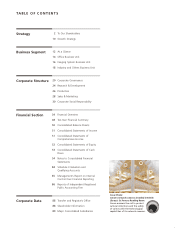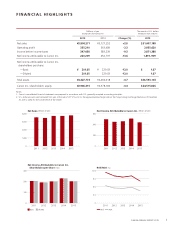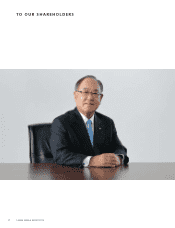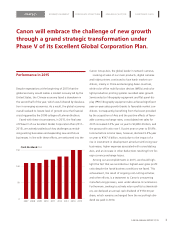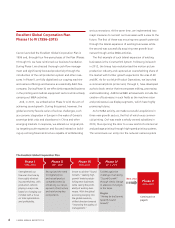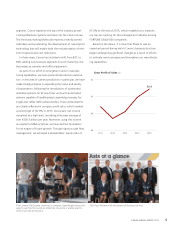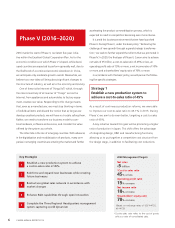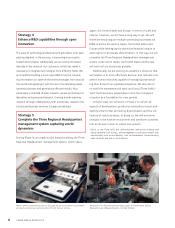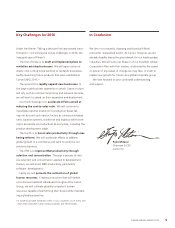Canon 2015 Annual Report Download - page 8
Download and view the complete annual report
Please find page 8 of the 2015 Canon annual report below. You can navigate through the pages in the report by either clicking on the pages listed below, or by using the keyword search tool below to find specific information within the annual report.
CANON ANNUAL REPORT 2015
66
2020 Management Targets
Net sales
¥5 trillion
*Cost-to-sales ratio
45% or less
Operating profi t ratio
15% or more
Net income ratio
10% or more
Shareholders’ equity ratio
70% or more
Key Strategies
Establish a new production system to achieve
a cost-to-sales ratio of 45%
Reinforce and expand new businesses while creating
future businesses
Restructure global sales network in accordance with
market changes
Enhance R&D capabilities through open innovation
Complete the Three Regional Headquarters management
system capturing world dynamism
1
2
3
4
5
Phase V (2016–2020)
2016 marks the start of Phase V, our latest fi ve-year initia-
tive within the Excellent Global Corporation Plan. As for the
economic conditions on which Phase V is based, while devel-
oped countries are expected to perform generally well, due to
the likelihood of a continued economic slowdown in China,
we anticipate only moderate growth overall. Meanwhile, we
believe two new tides will bring about signifi cant changes to
the structure of industry, as well as to the economy and society.
One of these is the Internet of Things (IoT) which, through
the interconnectivity of all manner of “things” across the
Internet, from appliances and automobiles to factory equip-
ment, creates new value. Responding to this change means
that, even as a manufacturer, we must stop thinking in terms
of individual items and discard the notion that as long as we
develop excellent products we will have no trouble selling them.
Rather, we need to transform our business model to com-
bine hardware, software and services, and consider the value
offered by the system as a whole.
The other tide is the rise of emerging countries. With advances
in the digitalization and modularization of products, many com-
panies in emerging countries are entering the market and further
accelerating the product commoditization process, which is
expected to result in competition becoming even more intense.
It is amid this business environment that we have launched
Phase V. During Phase V, under the basic policy “Embracing the
challenge of new growth through a grand strategic transforma-
tion,” we seek to further expand the reforms that we promoted in
Phase IV. In 2020, the fi nal year of Phase V, Canon aims to achieve
net sales of ¥5 trillion, a cost-to-sales ratio of 45% or less, an
operating profi t ratio of 15% or more, a net income ratio of 10%
or more, and a shareholders’ equity ratio of 70% or more.
In accordance with this basic policy, we will pursue the follow-
ing fi ve specifi c strategies.
Strategy 1
Establish a new production system to
achieve a cost-to-sales ratio of 45%
As a result of continuous production reforms, we were able
to improve our cost-to-sales ratio to 49.1% in 2015. During
Phase V, we aim to do even better, targeting a cost-to-sales
ratio of 45%.
A key initiative toward this goal will be promoting a higher
ratio of production in Japan. This shift offers the advantage
of integrating design, R&D and manufacturing functions,
allowing us to put together a competitive cost structure from
the design stage, in addition to facilitating cost reductions
(Based on exchange rates of US$1=¥125,
€1=¥135)
* Cost-to-sales ratio refers to the cost of goods
sold as a ratio of consolidated sales.


